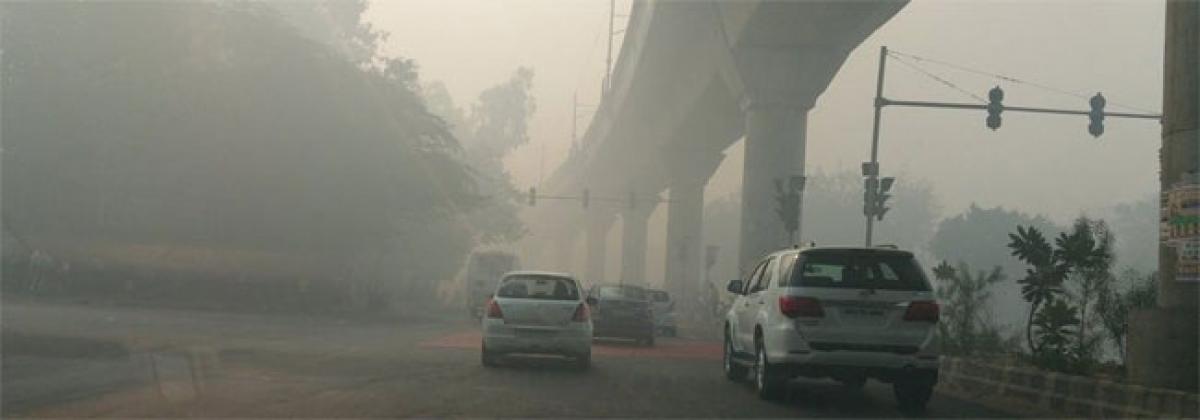Live
- CM discusses modalities with Union ministers
- Civic body to give boost to SHG group products
- Union Bank of India celebrates foundation day
- Thanks to Centre, AP on fast-track mode
- First Impressions and Unboxing of the MacBook Pro M4: A Powerhouse for Professionals and Creators
- China Gears Up for Potential Trade War Amid Trump’s Tariff Threats
- Small Farmers Gain Less by Selling to Supermarkets: Study Reveals
- Why Despite the Controversy, America Is Anticipating the Mike Tyson vs. Jake Paul Fight
- Sanju Samson and Tilak Varma Shine: Record-Breaking Feats in 4th T20I Against South Africa
- India Urges $1.3 Trillion Annual Climate Support for Developing Nations
Just In

Even though alarm bells are ringing on increasing pollution levels in the city limits, there has been no sincere efforts from the Andhra Pradesh Pollution Control Board APPCB that accords permission to industrial units and other activities Particulate Matter PM 10 is spreading in the city limits as damaged roads are posing serious health hazard to denizens
Nellore: Even though alarm bells are ringing on increasing pollution levels in the city limits, there has been no sincere efforts from the Andhra Pradesh Pollution Control Board (APPCB) that accords permission to industrial units and other activities. Particulate Matter (PM) 10 is spreading in the city limits as damaged roads are posing serious health hazard to denizens.
Representatives of the Centre for Science and Environment (CSE) also warned that the city needs 5-6 monitors for constant vigil on the pollutants. They also informed that the city is also one among the highly polluted cities in the state along with Vijayawada, Visakhapatnam, Guntur and Kurnool. In fact, Nellore is a cool place where pollution levels are under normal levels. But, for some time, the city has been facing high level of PM 10 which indicates necessary action to be taken by the state government for preventing pollution related diseases.
Particles of any substances are normally less than 10 or 2.5 micrometres diameter. Particles in this size range make up a large proportion of dust enter deep into the lungs stock in the nose, mouth or throat that create related disorders after some time, according to medical experts.
Environmentalists consider levels of Nitrogen Dioxide (SO2), Nitrogen Dioxide (NO2), PM 10, PM 2.5, ozone, lead, arsenic, nickel, Carbon Monoxide (CO), NH3, benzene, and BaP (particulate phase).
Across cities, only SO2, NO2 and Respirable Suspended Particulate Matter (RSPM)/PM10 are monitored commonly following National Ambient Air Quality Standards (NAAQS) in urban areas by the Central Pollution Control Board (CPCB).
The APPCB started assessing the ambient air quality in the state with the help of its 3 Zonal Laboratories located at Visakhapatnam, Vijayawada and Kurnool and nine regional offices to carry out the activities laid down in the Air (Prevention and Control of Pollution) Act, 1981.
A network with 41 ambient air quality monitoring stations have been set up across the state to assess the air quality and its changes. A real-time monitor has been set at Tirumala which also monitors air pollutants in Nellore city too.
The CSE recommended 5 exclusive monitors for Nellore for round-the-clock vigil on the levels for taking further steps to reduce levels with constructive efforts by various line departments. Nellore city has been facing severe pollution problem for the last 6-8 months with ongoing roads, water and underground drainage works where the contract agencies are ignoring difficulties of people disregarding following precautions not to spread dust related allergies and serious diseases.
The administration has to set up a committee with District Collector as Chairman along with senior officials such as Municipal Commissioner, Civil Supplies Officer, Deputy Transport Commissioner (DTC), Assistant Controller-Weights and Measures, DIC General Manager and Environmental Engineer of PCB as its members.
It has been done but there has been no action against deficiencies in the city due to influence of politicians. The blame game starts among line departments, who normally accuse vehicular pollution which is the main culprit for spoiling city life.
The committee instructed the DTC for taking measures to reduce the concerned levels. Thanks to the hierarchy where each one blames others for the mistakes of common. It has been decided a year ago to develop greenery, fill potholes, arranging water fountains in traffic islands and clear garbage on the city roads for reducing air pollution. Now, dust pollution added to the list of pollutants due to ongoing works.

© 2024 Hyderabad Media House Limited/The Hans India. All rights reserved. Powered by hocalwire.com







